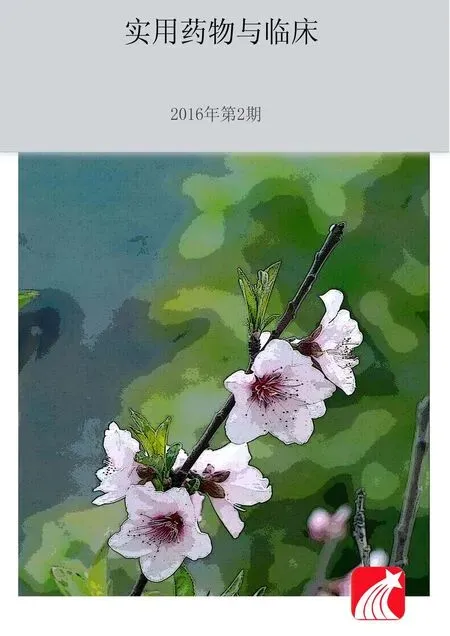托泊替康单药及与奥沙利铂联用治疗铂耐药性卵巢癌的临床研究
朱慧婷,高 嵩
中国医科大学附属盛京医院妇科肿瘤病房,沈阳 110004
托泊替康单药及与奥沙利铂联用治疗铂耐药性卵巢癌的临床研究
朱慧婷,高嵩*
中国医科大学附属盛京医院妇科肿瘤病房,沈阳 110004
[摘要]目的回顾性分析奥沙利铂联合托泊替康与托泊替康单药在铂耐药性卵巢癌治疗中的疗效及安全性。方法纳入铂耐药性卵巢癌患者41例,使用奥沙利铂联合托泊替康方案患者21例,托泊替康单药方案患者20例。奥沙利铂联合托泊替康组给药方案:奥沙利铂130 mg/m2d1,托泊替康1.75~2 mg/m2d1、d8、d15,每3周重复1次;托泊替康组给药方案:托泊替康1.75~2 mg/m2d1、d8、d15,每3周重复1次。每组的主要研究终点为疾病总缓解率[完全缓解率(CR)+部分缓解率(PR)]、疾病控制率[CR+PR+疾病稳定(SD)]和无进展生存期(PFS);次要研究终点为化疗副反应事件,包括:血液学毒性、胃肠道毒性及肝肾功损伤。每2~3个化疗周期后,采用实体瘤疗效评价标准1.1版评价临床缓解率;化疗副反应事件采用常见不良反应事件评价标准 4.0版评价。结果奥沙利铂联合托泊替康组、托泊替康组的总缓解率分别为33.3%、15.0% (P=0.172),疾病控制率分别为66.7%、35.0% (P<0.05),平均无进展生存期分别为5.1、2.3个月(P<0.05)。两组的主要不良反应均为血液学毒性、胃肠道毒性及肝功能损伤,两组比较差异无统计学意义(P>0.05)。结论奥沙利铂联合托泊替康方案为铂耐药性卵巢癌患者提供了更加有效的辅助化疗方案,且毒副作用可耐受。
[关键词]奥沙利铂;托泊替康;铂耐药性卵巢癌
0引言
上皮性卵巢癌是引起女性恶性肿瘤相关死亡的主要疾病之一[1],75%的患者在确诊时已处于晚期(Ⅲ~Ⅳ期),Ⅳ期卵巢癌患者的5年生存率仅为18%[2]。其主要治疗方法为肿瘤细胞减灭术及以铂类药物为基础的辅助化疗,铂类药物联合紫杉醇为目前标准的一线化疗方案[3]。尽管患者对初次化疗的反应良好,但多数患者在2年内会出现疾病复发[4]。 铂耐药性卵巢癌指在完成以铂类药物为基础的化疗后6个月内(无铂间歇期≤6个月)出现复发的卵巢癌[5],比铂敏感性卵巢癌(无铂间歇期>6个月)预后更差,化疗效果不佳。因此,寻求更加有效、安全的二线化疗方案对铂耐药性卵巢癌患者具有重大意义。托泊替康为拓扑异构酶-Ⅰ抑制剂,在铂耐药性卵巢癌中已有深入研究[6-8]。托泊替康与紫杉醇的药物作用相似[9]且无交叉耐药性[10],与其他细胞毒性药物可产生协同作用[11],为治疗铂耐药性卵巢癌最常用的化疗药物之一。奥沙利铂为第三代铂类衍生物,是一种带有1,2-二氨基环己烷载体配体的化合物,与顺铂、卡铂没有交叉耐药性[12-14],常与顺铂、紫杉醇、吉西他滨、5-FU联用[15]。至今少有临床实验观察奥沙利铂联合托泊替康方案治疗铂耐药性卵巢癌的疗效及安全性。本研究通过回顾性比较分析的方法,观察奥沙利铂(L-OHP)联合托泊替康(TPT)与托泊替康单药方案治疗铂耐药性卵巢癌患者的疗效及安全性。
1材料与方法
本研究对使用奥沙利铂+托泊替康和托泊替康单药方案治疗铂耐药性卵巢癌患者的疗效与安全性进行回顾性比较分析。收集2012年1月至2015年8月在我院妇科肿瘤病房使用该两组方案治疗铂耐药性卵巢癌患者的医疗记录,共有41例患者符合本研究标准。
1.1纳入标准患者有明确的上皮性卵巢癌组织学诊断,无铂间歇期≤6个月,有靶病灶(根据RECIST v.1.1标准)。患者年龄≥18岁,美国东部肿瘤协作组(ECOG)体力状况≤2,具备合格的肝肾功能、心功能及骨髓功能:血红蛋白≥9 g/dL;粒细胞绝对计数≥1 500/μL,血小板计数≥100 000/μL,血肌酐≥1.5 mg/dL或肌酐清除率≥60 mL/min,直接胆红素≤正常值上限(ULN),总胆红素≤1.5×ULN,AST、ALT≤2.5×ULN。此外,患者在接受本次治疗前1个月内没有接受过化疗、激素治疗、免疫治疗及放疗。
1.2治疗方案奥沙利铂联合托泊替康组(联合组):静脉滴注,每21 d为1个疗程。奥沙利铂130 mg/m2d1,托泊替康1.75~2 mg/m2d1、d8、d15。托泊替康组(对照组):静脉滴注,每21 d为1个疗程。托泊替康1.75~2 mg/m2d1、d8、d15。
1.3疗效及安全性评价完成2~3个疗程化疗后,采用实体瘤疗效评价标准1.1版(RECIST v.1.1)评价疗效。主要研究终点是疾病总缓解率[完全缓解率(CR)+部分缓解率(PR)],疾病控制率[CR+PR+疾病稳定(SD)]和无进展生存期(PFS),次要研究终点为化疗副反应事件。CR:经体格检查及影像学检查发现所有可见病灶完全消失且至少维持4周;PR:双径可测量病灶最大两垂直径的乘积之和减少50%以上并至少维持4周;PD:病灶总体积增加20%以上或出现新发病灶。未达到部分缓解和疾病进展的标准定义为SD。PFS定义为用药第1天至出现临床确诊疾病进展的时间。化疗副反应采用常见不良反应事件评价标准 4.0版(CTCAE v.4.0)评价。患者化疗期间每周复查1次血常规及肝肾功,每2~3个疗程后完善1次全身CT检查,有心脏疾病病史的患者每进行2个疗程后进行1次心脏彩超检查。患者化疗结束后2年内,每3个月评估1次病情及化疗远期毒副作用;此后每6个月复查1次。复查内容包括影像学检查、体格检查、血生化检查及CA125水平。心脏功能在化疗结束后2年内每半年采用心电图和超声心动图评估1次,其后每年检查1次。
1.4数据分析患者特征、临床缓解率及化疗副反应事件的比较采用Fisher精确概率法计算。PFS用Kaplan-Meier法计算,log-rank检验分析两组间PFS有无差异。所有数据由SPSS 20.0软件分析。P<0.05为差异有统计学意义。
2结果
2.1患者特征2012年1月至2015年8月共有41例铂耐药性卵巢癌患者被纳入本次回顾性比较分析研究,其中21例接受L-OHP+TPT方案,20例接受TPT方案。两组患者的原发病灶组织学分型、原始FIGO分期及WHO 体力状况评级(ECOG)等差异无统计学意义,见表1。
2.2疗效评价2个疗程后,联合组RR略高于对照组,但差异无统计学意义(P=0.172);联合组DCR高于对照组,差异有统计学意义(P=0.043);两组PFS比较差异有统计学意义(P<0.05)。见表2、图1。
2.3依从性和化疗毒性评价L-OHP+TPT组和TPT组化疗周期的中位数分别是4(2~7)和3(2~8)个疗程,分别有2例(9.5%)和1例(5%)患者进行了至少6个疗程化疗。其中L-OHP+TPT组有13例(61.9%)因化疗毒性反应减量,4例(19%)化疗延期超过1周;TPT组有3例(15%)因化疗毒性反应减量,1例(5%)延期化疗1周以上。L-OHP+TPT组有1例(4.8%)患者在化疗过程中因化疗毒性反应终止化疗。
两组毒副反应均以血液学毒性、胃肠道毒性最为常见,其中以中性粒细胞减少症的发生率最高,分别为5例(23.8%)及2例(10%)。L-OHP+TPT组有3例因严重的血液毒性而延期化疗1周以上,TPT组仅有1例。结果表明,L-OHP+TPT组更易发生3~4级血红蛋白减少症和中性粒细胞减少症,但两组间差异无统计学意义。L-OHP+TPT组和TPT组均未出现治疗相关性死亡事件的发生。两组之间的其他毒性反应相似。

表1 两组患者临床特征比较(例)

表2 两组临床疗效比较(例,%)

图1 两组无进展生存期比较
3讨论
复发性卵巢癌的治疗仍是临床上尚未攻克的难题之一,挽救性化疗的主要目的是控制肿瘤生长、延长生存时间和保证生活质量,但目前采用的二线化疗方案均不能有效提高患者的疾病缓解率及生存时间。
本研究为首次观察奥沙利铂联合托泊替康方案治疗铂耐药性卵巢癌疗效及安全性的临床研究,其总缓解率可达33.3%,平均PFS达5.1个月,提示该方案对铂耐药性卵巢癌有良好疗效。近年大量临床试验证实,托泊替康联合化疗方案治疗效果优于单药方案。Verhaar等[16]使用托泊替康联合脂质体阿霉素方案治疗铂耐药性卵巢癌患者,总有效率达28%,平均PFS为7.5个月。Greggi等[17]证实,托泊替康联合吉西他滨治疗铂耐药性卵巢癌患者的总有效率达12.5%。Kang等[18]进行的一项Ⅱ期临床试验证明,托泊替康联合卡铂治疗复发性(包括铂敏感性及铂耐药性)卵巢癌的总有效率达26.4%。另有研究表明,托泊替康联合索拉非尼治疗铂耐药性卵巢癌的总有效率达16.7%[19]。一些Ⅱ期临床试验提示,托泊替康单药治疗铂耐药性卵巢癌的总缓解率为14%~18%[8,20-22],本研究中总有效率为15%,与以上临床试验结果一致,也证实了托泊替康联合化疗方案治疗效果优于单药方案的结论。因此,奥沙利铂联合托泊替康可作为安全、有效的辅助化疗方案治疗铂耐药性卵巢癌,临床上值得推广。
本研究回顾性比较了奥沙利铂联合托泊替康与托泊替康单药治疗铂耐药性卵巢癌的疗效及安全性,结果表明,L-OHP+TPT组的总缓解率(差异无统计学意义)、疾病控制率及平均PFS均高于TPT组,说明L-OHP+TPT方案疗效优于TPT单药方案。L-OHP+TPT组与TPT组的Ⅲ~Ⅳ级副反应事件中以血液学和胃肠道毒性反应最常见,前者因毒副反应导致化疗减量的患者占61.9%,而后者仅为15%,可见L-OHP+TPT组毒副反应略严重,但两组间差异无统计学意义。L-OHP+TPT组的血液学毒性发生率略高于TPT组,更易发生3~4级血红蛋白减少症和中性粒细胞减少症,但差异无统计学意义。L-OHP+TPT组和TPT组均未出现神经毒性反应,也没有治疗相关性死亡事件的发生。本研究结果表明,奥沙利铂联合托泊替康方案在疗效方面优于托泊替康单药方案,而在安全性方面两组方案并无明显区别。 托泊替康为拓扑异构酶Ⅰ抑制剂,拓扑异构酶Ⅰ在DNA的复制和转录机制中起重要作用[23]。考虑托泊替康可干扰DNA修复且与其他细胞毒性药物可产生协同作用,因此推测托泊替康与损伤DNA的化疗药物联用时,可增强其细胞毒性作用。奥沙利铂是治疗复发性卵巢癌最常用的药物之一,与顺铂及卡铂没有交叉耐药性。此外,有研究表明,奥沙利铂通过产生水化衍生物作用于DNA,形成链内和链间交联,从而抑制DNA的合成,产生细胞毒作用和抗肿瘤活性。这可能是托泊替康联合奥沙利铂优于其他托泊替康联合化疗方案及单药方案的原因。
参考文献:
[1]Siegel R,Naishadham D,Jemal A.Cancer statistics[J].CA:Cancer Journal for Clinicians,2012,62(1):10-29.
[2]Huang L,Cronin KA,Johnson KA,et al.Improved survival time:What can survival cure models tell us about population-based survival improvements in late-stage colorectal,ovarian,and testicular cancer[J].Cancer,2008,112(10):2289-2300.
[3]Sugano T,Katsumata N.Ovarian cancer:TC therapy.Nihon rinsho[J].Japanese Journal of Clinical Medicine,2015,73:604-608.
[4]Gardner GJ,Jewell EL.Current and future directions of clinical trials for ovarian Cancer[J].Cancer Control Journal of the Moffitt Cancer Center,2011,18(1):44-51.
[5]Colombo N,Gore M.Treatment of recurrent ovarian cancer relapsing 6-12 months post platinum-based chemotherapy[J].Critical Reviews In Oncology/Hematology,2007,64(2):129-138.
[6]Markman M.New,expanded,and modified use of approved antineoplastic agents in ovarian cancer[J].The Oncologist,2007,12(2):186-190.
[7]Armstrong DK,Spriggs D,Levin J,et al.Hematologic safety and tolerability of topotecan in recurrent ovarian cancer and small cell lung cancer:an integrated analysis[J].The Oncologist,2005,10(9):686-694.
[8]Safra T,Berman T,Yachnin A,et al.Weekly topotecan for recurrent ovarian,fallopian tube and primary peritoneal carcinoma:Tolerability and efficacy study-The Israeli experience[J].International Journal of Gynecological Cancer,2013,23(3):475-480.
[9]Peng LH,Chen XY,Wu TX.Topotecan for ovarian cancer[J].The Cochrane Database of Systematic Reviews,2007,(2):CD005589-CD005589.
[10]Gore M,Ten Bokkel Huinink W,Carmichael J,et al.Clinical evidence for topotecan-paclitaxel non-cross-resistance in ovarian cancer[J].Journal of Clinical Oncology,2001,19(7):1893-1900.
[11]Kaufmann SH,Peereboom D,Buckwalter CA,et al.Cytotoxic effects of topotecan combined with various anticancer agents in human cancer cell lines[J].Journal of National Cancer Institute,1996,88(11):734-741.
[12]Misset JL,Bleiberg H,Sutherland W,et al.Oxaliplatin clinical activity:a review[J].Critical Reviews in Oncology/hematology,2000,35(2):75-93.
[13]Stukova M,Hall MD,Tsotsoros SD,et al.Reduced accumulation of platinum drugs is not observed in drug-resistant ovarian cancer cell lines derived from cisplatin-treated patients[J].Journal of Inorganic Biochemistry,2015,149:45-48.
[14]Desoize B,Madoulet C.Particular aspects of platinum compounds used at present in cancer treatment[J].Critical Reviews in Oncology/hematology,2002,42(3):317-325.
[15]Culy CR,Clemett D,Wiseman LR.A review of its pharmacological properties and clinical efficacy in metastatic colorectal cancer and its potential in other malignancies[J].Drugs,2000,60:895-924.
[16]Verhaar-Langereis M,Karakus A,Van Eijkeren M,et al.Phase II study of the combination of pegylated liposomal doxorubicin and topotecan in platinum-resistant ovarian cancer[J].International Journal of Gynecological Cancer,2006,16(1):65-70.
[17]Greggi S,Salerno MG,D′Agostino G,et al.Topotecan and gemcitabine in platinum/paclitaxel-resistant ovarian cancer[J].Oncology,2001,60(1):19-23.
[18]Kang H,Kim TJ,Lee YY,et al.Topotecan combined with carboplatin in recurrent epithelial ovarian cancer:results of a single-institutional phase II study[J].Gynecologic Oncology,2009,114(2):210-214.
[19]Ramasubbaiah R,Perkins SM,Schilder J,et al.Sorafenib in combination with weekly topotecan in recurrent ovarian cancer,a phase I/II study of the Hoosier Oncology Group[J].Gynecologic Oncology,2011,123(3):499-504.
[20]Kudelka AP,Tresukosol D,Edwards CL,et al.Phase II study of intravenous topotecan as a 5-day infusion for refractory epithelial ovarian carcinoma[J].Journal of Clinical Oncology,1996,14(5):1552-1557.
[21]Swisher EM,Mutch DG,Rader JS,et al.Topotecan in platinum-and paclitaxel-resistant ovarian cancer[J].Gynecologic Oncology,1997,66(3):480-486.
[22]Bookman MA,Malmström H,Bolis G,et al.Topotecan for the treatment of advanced epithelial ovarian cancer:an open-label phase II study in patients treated after prior chemotherapy that contained cisplatin or carboplatin and paclitaxel[J].Journal of Clinical Oncology,1998,16(10):3345-3352.
[23]Xu Y,Her C.Inhibition of topoisomerase (DNA) I (TOP1):DNA damage repair and anticancer therapy[J].Biomolecules,2015,5:1652-1670.
Clinical study on the efficacy of topotecan monotherapy and oxaliplatin plus topotecan in the treatment of patients with platinum-resistant ovarian cancerZHU Hui-ting,GAO Song*(Gynecologic Oncology Ward,Shengjing Hospital of China Medical University,Shenyang 110004,China)
[Abstract]ObjectiveTo retrospectively compare the efficacy and safety of oxaliplatin plus topotecan and single use of topotecan on patients with platinum-resistant ovarian cancer.MethodsForty one patients with platinum-resistant ovarian cancer were enrolled and divided into two groups.Patients in combination group (n=21) received oxaliplatin plus topotecan polichemotherapy (oxaliplatin 130 mg/m2d1,topotecan 1.75~2 mg/m2at d1,d8 and d15 every 3 weeks),patients in topotecan group (n=20) received topotecan monochemotherapy (topotecan 1.75~2 mg/m2at d1,d8 and d15 every 3 weeks).The primary end points study included overall response rate which contained complete response (CR)+partial response (PR),disease control rate which contained CR+PR+stable disease (SD) and progression-free survival (PFS); the secondary study end point included adverse effects of chemotherapy,such as hematological toxicity,gastrointestinal toxicity,hepatic and renal dysfunction.Clinical response was evaluated every 2 or 3 cycles using the Response Evaluation Criteria in Solid Tumors criteria v.1.1.Adverse effects of chemotherapy were evaluated using Common Terminology Criteria for Adverse Events (CTCAE) v.4.0.ResultsThe total remission rate,disease control rate and PFS in combination group and topotecan group were 33.3% and 15.0%,66.7% and 35.0%,5.1 and 2.3 months respectively,there were significant differences in disease control rate and PFS between the two groups (P<0.05).The main adverse reactions in both groups included hematological toxicity,gastrointestinal toxicity and liver toxicity.No significant difference was found in adverse reactions between the two groups (P>0.05).ConclusionOxaliplatin plus topotecan polichemotherapy provides more efficient adjuvant chemotherapy for patients with platinum-resistant ovarian cancer than topotecan monochemotherapy,and the toxic side effects are tolerable.
Key words:Oxaliplatin;Topotecan;Platinum-resistant ovarian cancer
DOI:10.14053/j.cnki.ppcr.201602004
*通信作者
收稿日期:2015-10-05

